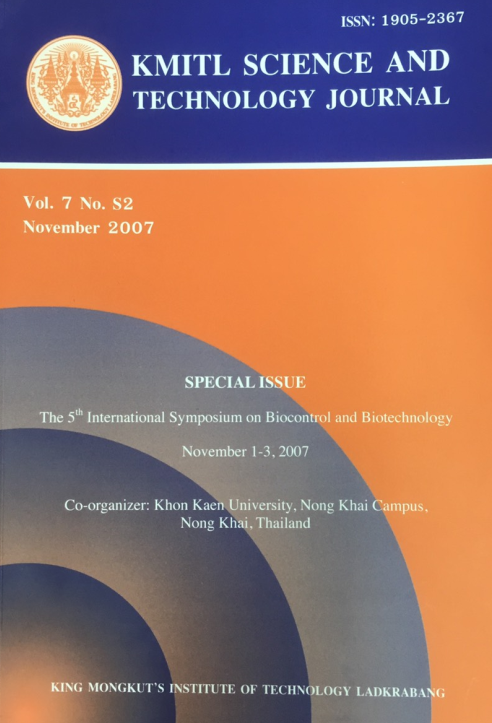ISOLATION OF PHOSPHATE SOLUBILIZING FUNGI IN SOIL FROM KANCHANABURI, THAILAND
Main Article Content
Abstract
Phosphorus replenishment, particularly in smallholder agriculture, remains a challenge as it is mainly fertilizer dependent. While the user of soluble mineral phosphate fertilizers is the obvious best means to combat phosphate deficiency in soil, they were limited by high cost of fertilizers and availability at farmer’s level. This research is to isolate and select phosphate solubilizing soil fungi from Kanchanaburi area. One hundred and forty five fungi isolates were incubated on Pikovskaya agar supplemented with 0.003% w/v rose bengal, isolates which gave the high ratio of clear zone were selected. Four fungal strains out of 30 strains, i.e., SA07P3332, SA22P3406, SA14P2418 and SA19P2120 solubilized tricalcium phosphate and showed the highest available phosphate in liquid medium. The available phosphate were 3.010, 2.993, 2.749 and 2.632 mg P2O5 ml-1, respectively. All of the fungal strains are fast growing black colonies on potato dextrose agar with distinctive conidial heads characterized as Aspergillus sp. Their phosphatase enzyme activities were 0.029-0.102 unit ml-1 min-1 for acid phosphatase (pH 6.5) and 0.022-0.102 unit ml-1 min-1 for alkaline phosphatase (pH 11).
Keywords: phosphate solubilizing fungi, phosphatase and available phosphate
Corresponding author: E-mail: kjmarisa@gmail.com
Article Details
Copyright Transfer Statement
The copyright of this article is transferred to Current Applied Science and Technology journal with effect if and when the article is accepted for publication. The copyright transfer covers the exclusive right to reproduce and distribute the article, including reprints, translations, photographic reproductions, electronic form (offline, online) or any other reproductions of similar nature.
The author warrants that this contribution is original and that he/she has full power to make this grant. The author signs for and accepts responsibility for releasing this material on behalf of any and all co-authors.
Here is the link for download: Copyright transfer form.pdf
References
[2] Kang, C.S., Ha, G.C, Tae, G.L. and Maheshwari, K.D. 2002 Solubilization of Insoluble Inorganic Phosphates by a Soil Inhabiting Fungus Fomitopsis sp. SP 102, Current Science, 82(4), 439-442.
[3] Reddy, S.M., Kumar, S., Babita, K. and Reddy, M.S. 2002 Biosolubilization of Poorly Soluble Rock Phosphates by Aspergillus tubingensis and Aspergillus niger, Bioresource Technology, 84, 187-189.
[4] Hu, X., Chen, J. and Guo, J. 2006 Two Phosphate- and Potassium- Solubilizing Bacteria Isolated from Tianmu Mountain, Zhejiang, China. World Journal of Microbiology & Biotechnology, 22, 983-990.
[5] Coyne, M. 1999 Lab Mannual to Accompany Soil Microbiology: An Exploratory Approach. Franue Delmer Publishers.
[6] Taweenut, N. 2003 Master of Science Thesis (Agriculture). Chiang Mai University. Thailand
[7] AOAC. 1997 Official Methods of Analysis of AOAC. 16 th Ed. Vol. 1.
[8] Achal, V., Savant, V.V. and Reddy S.M. 2007 Phosphate Solubilization by a Wild Type Strain and UV-induced Mutants of Aspergillus tubingensis, Soil Biology and Biochemistry, 39, 695-699.
[9] Vazquez, P., Holguin, G., Puente, E.M., Lopez-Cortes, A. and Bashan, Y. 2000 Phosphate-Solubilizing Microorganisms Associated with the Rhizosphere of Mangroves in a Semiarid Coastal Lagoon, Biology and Fertility of Soils, 30, 5-6.
[10] Omar, A.S. 1998 The Role of Rock-Phosphate-Solubilizing Rungi and Vesicular-Arbuscular-Mycorrhiza (VAM) in Growth of Wheat Plants Fertilized with Rock Phosphate, World Journal of Microbiology and Biotechnology, 14, 211-218.
[11] Pradhan, N. and Sukla L.B. 2006 Solubilization of Inorganic Phosphates by Fungi Isolated from Agriculture Soli, African Journal of Biotechnology, 5(10), 850-854.


